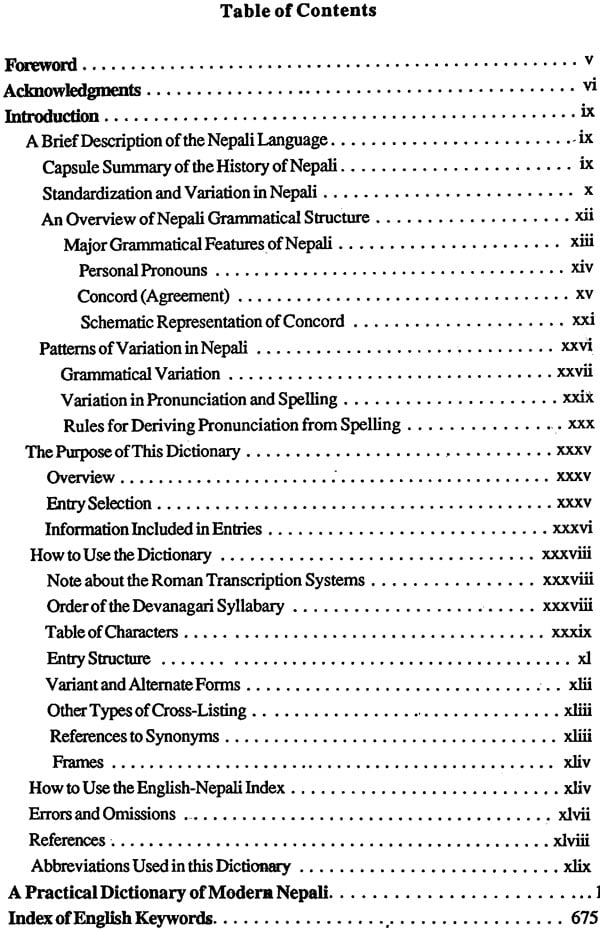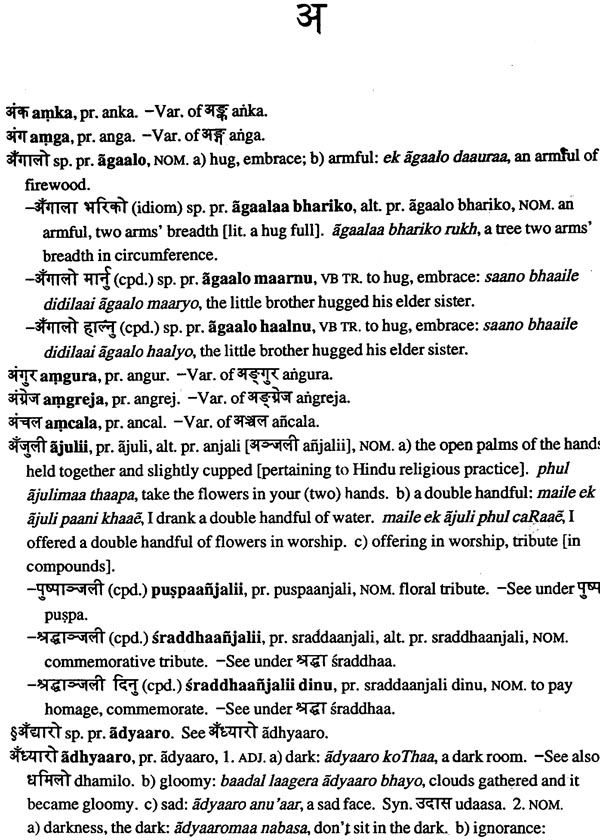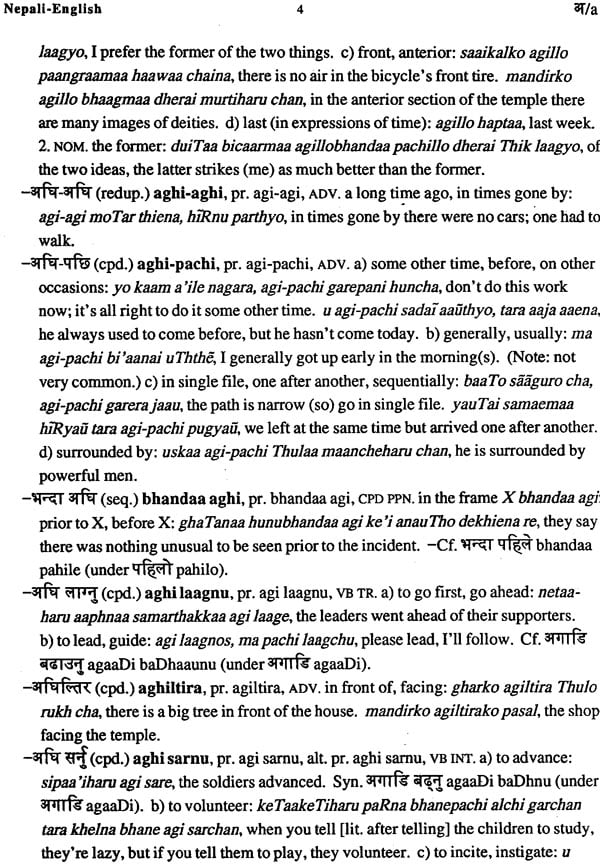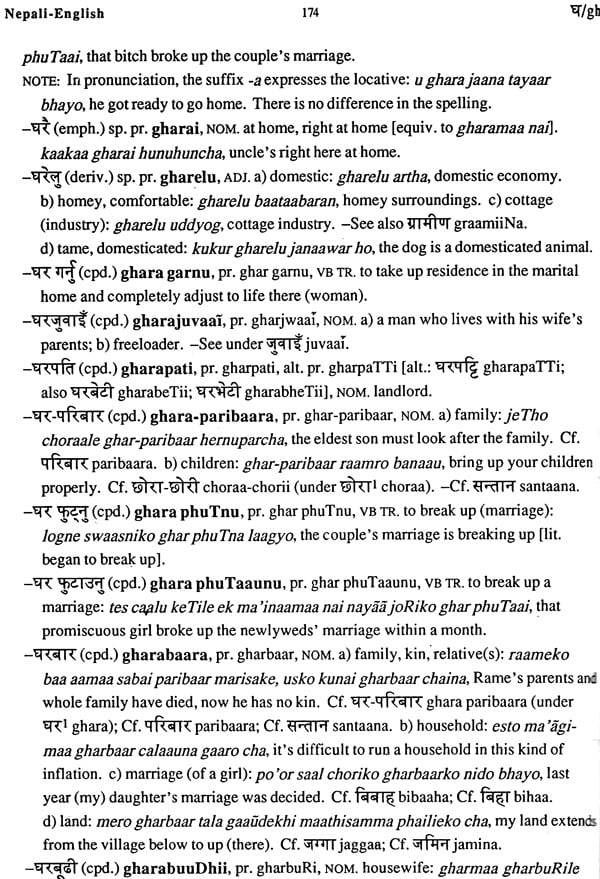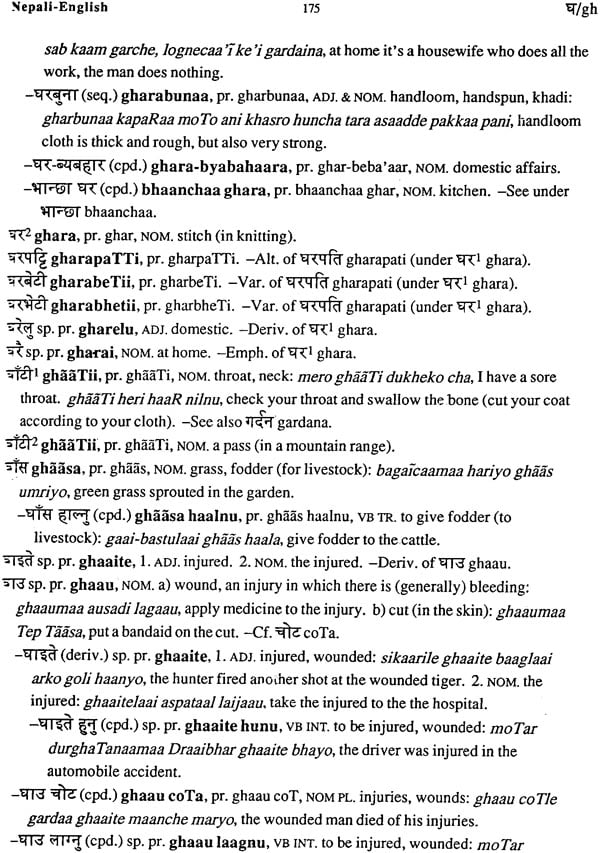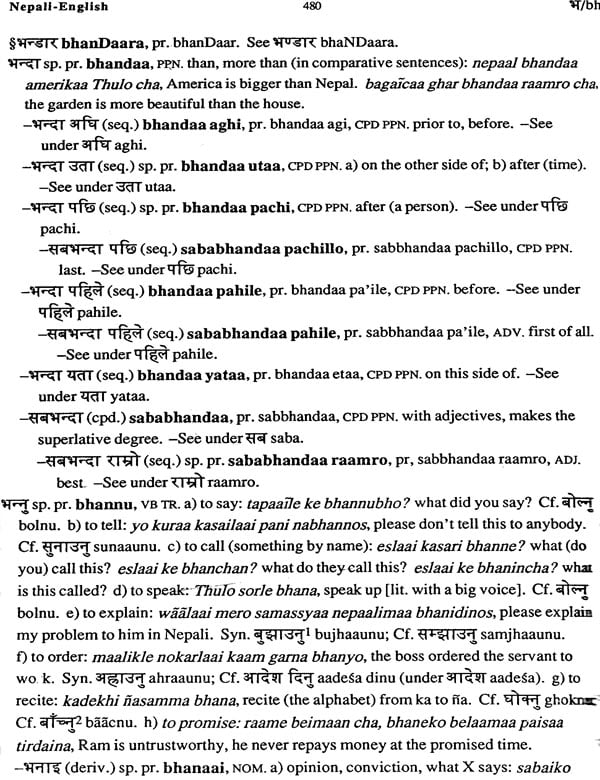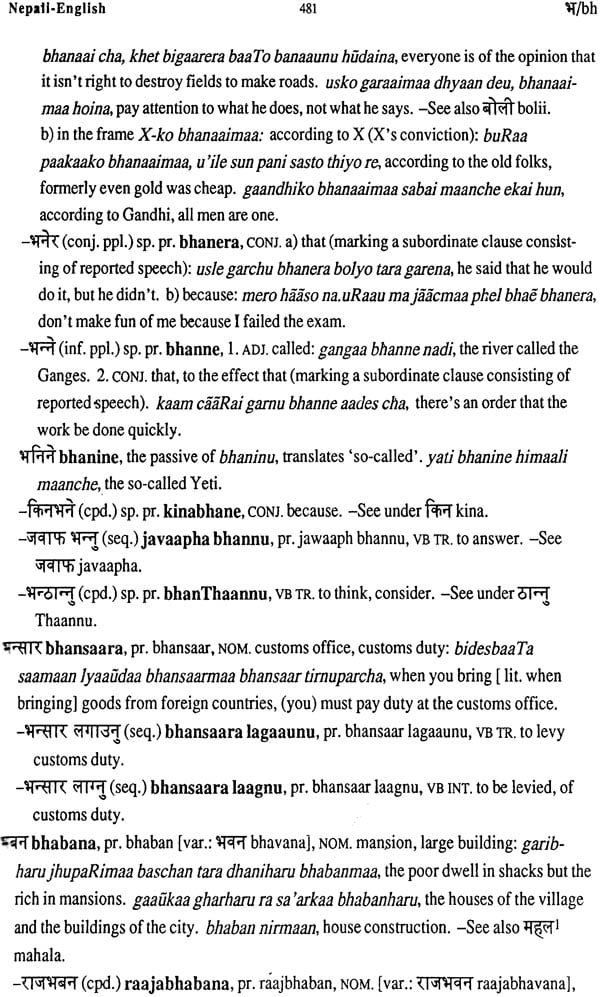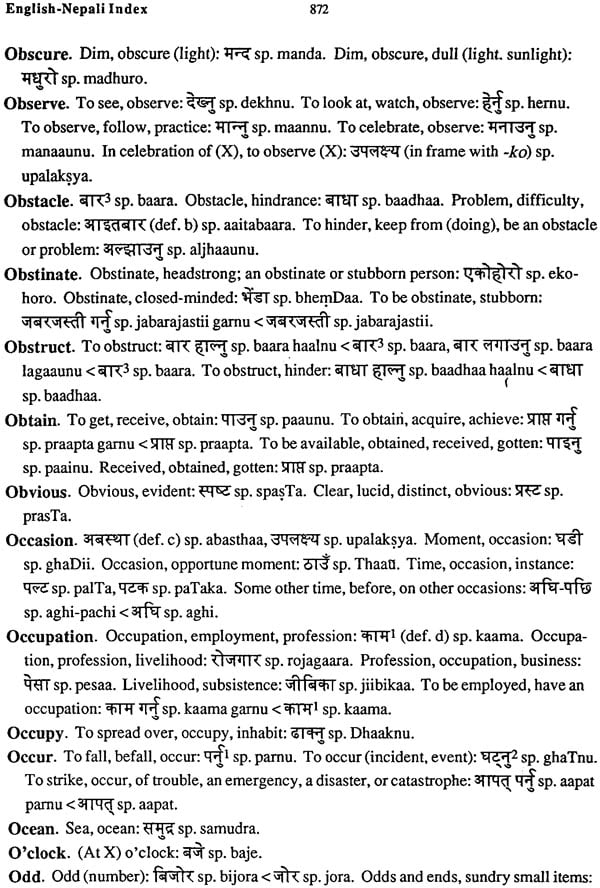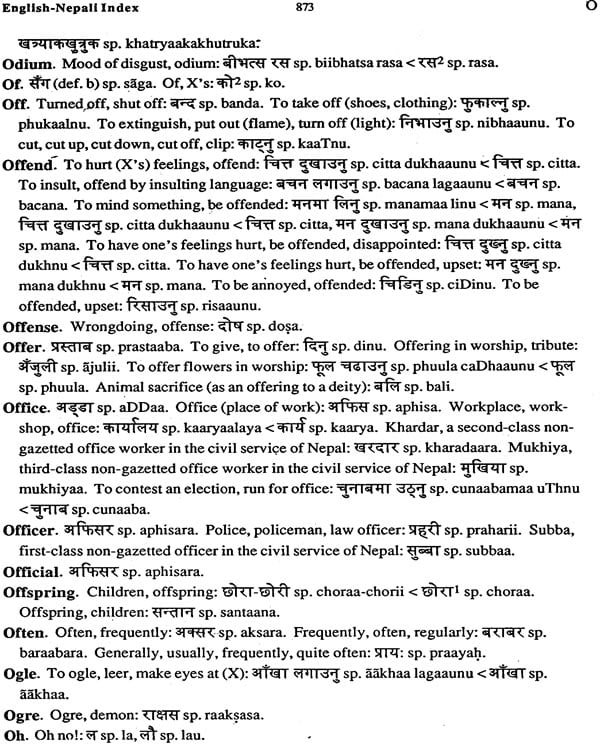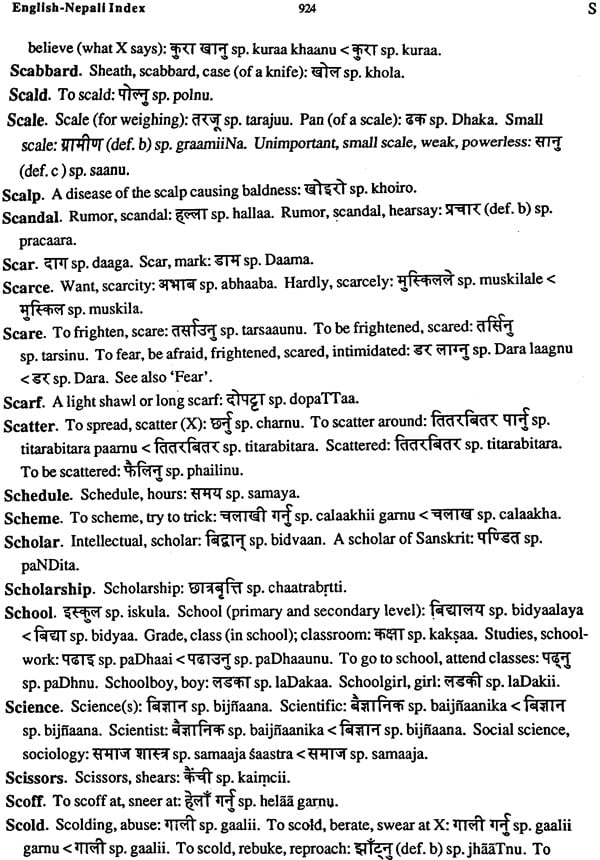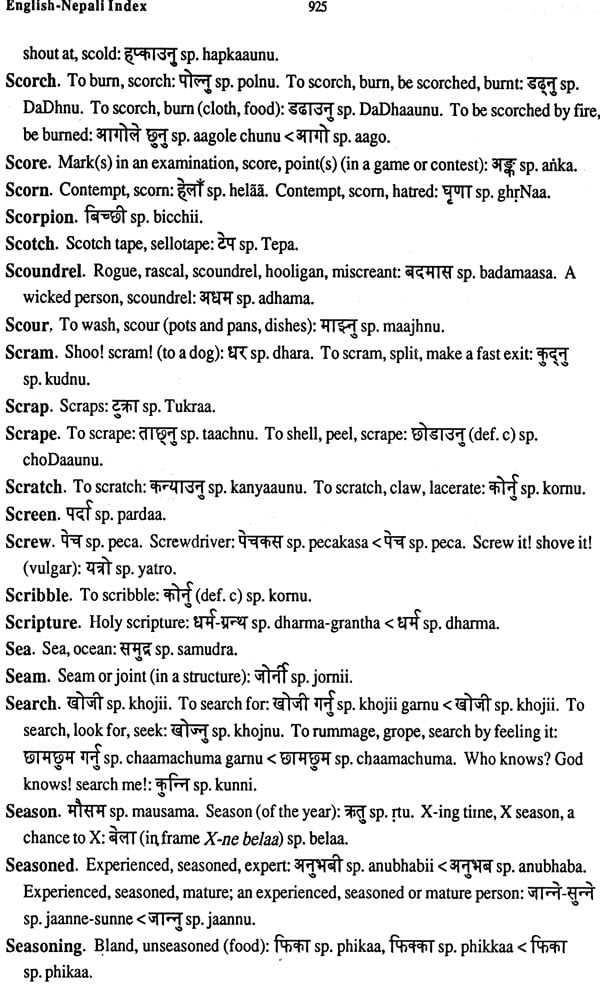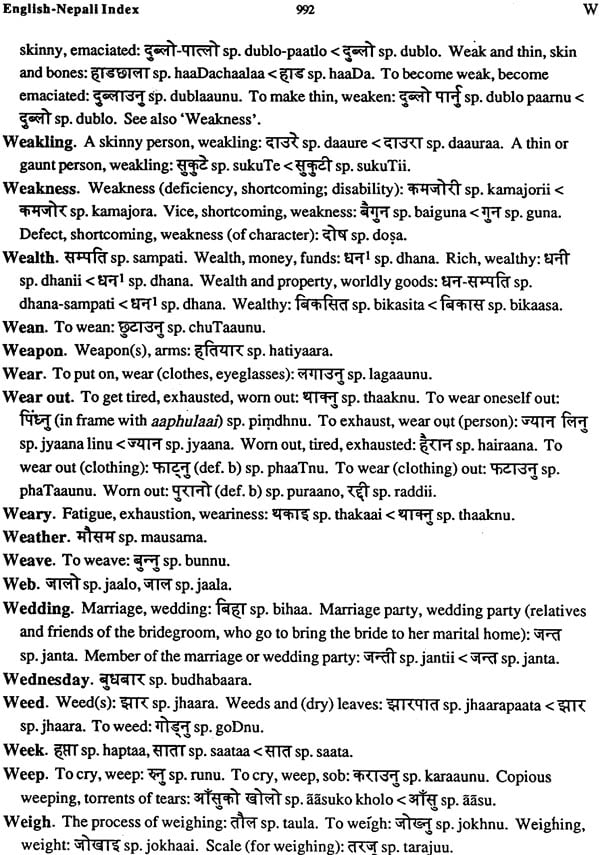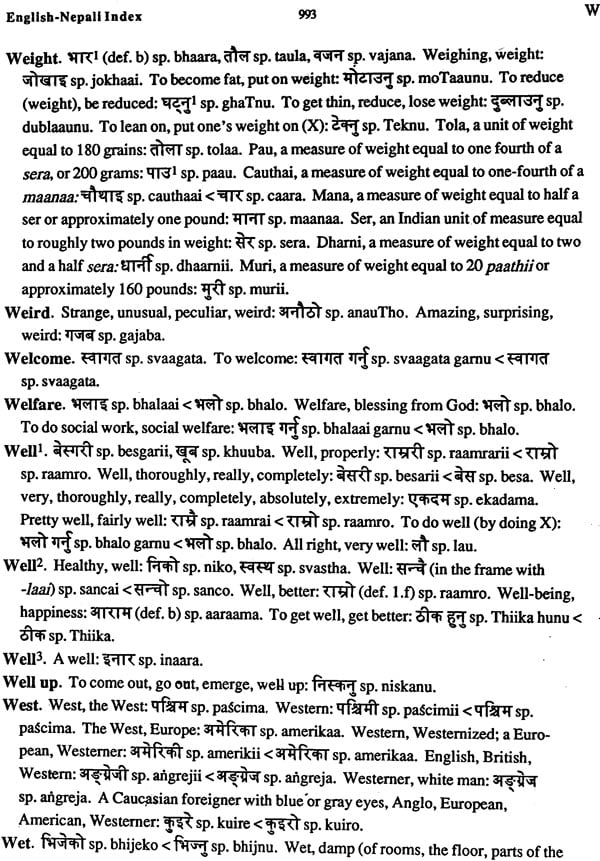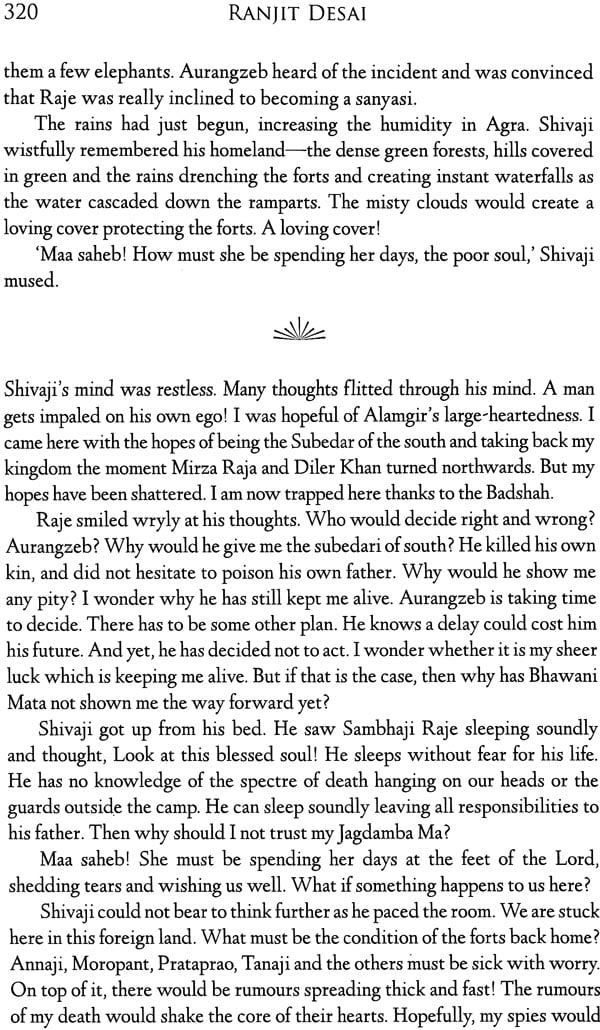
व्यावहारिक नेपाली-अङ्ग्रेजी शब्दकोश (A Practical Dictionary of Modern Nepali)
Book Specification
| Item Code: | NAQ466 |
| Publisher: | Ratna Sagar |
| Language: | Nepali text with English translations |
| Edition: | 2009 |
| ISBN: | 8170701724 |
| Pages: | 1045 |
| Cover: | HARDCOVER |
| Other Details | 8.50 X 5.50 inch |
| Weight | 700 gm |
Book Description
Since A Practical Dictionary of Modern Nepali is meant for learners at all levels, the entries are given in both the dcvanagari script,which is the normal medium for writing and reading Nepali, as well as in a transliteration and transcription system in the roman alphabet. The many illustrations are given only in the roman transcription, in order to keep the bulk of the Dictionary from increasing to an unmanageable size. This transcription should be readily under-stood by both the experienced reader of Nepali, as well as to the learner who has yet to learn the elegant and efficient devanagari script.
Nearly seven years of continuous effort has gone into the research, compilation, review, and production of A Practical Dictionary of Modern Nepali. This work was supported by a series of grants from the U.S. Department of Education and was carried on both in Nepal and at the University, of California at Berkeley, and involved the coperation of many Nepalis and Americans.
In reviewing the text of the Dictionary before publication, the editor-in-chief and the project director are well aware of the possibility for improvement and expansion of the Dictionary. It is our hope that users of this Dictionary will alert us to oversights, additional entries, and improvements in format and conventions which will make a second edition even more useful to the next generation of learners.
In the Acknowledgments which follow are listed the individuals who have contributed so much to the completion of the Dictionary. How-ever, I wish to take this opportunity to personally thank Dr. Ruth L. Schmidt, the Editor-in-Chief, for her innumerable and absolutely essential contributions to this publication. She has been the driving force behind this project since the beginning, and has unstintingly devoted much of her time over the past years to planning, organizing, coordinating, and actually writing, correcting, and producing much of the dictionary text. It was only her perseverance, dedication, and expertise which led to the completion of this project and the long-anticipated publication of A Practical Dictionary of Modern Nepali.
Scholars have traditionally distinguished three major stages in the evolution of these languages: (1) Old Indo-Aryan [01A], represented by the language of Rig Veda and classical Sanskrit; (2) Middle Indo-Aryan [MIA], including the Prakrit and Apabliramga speeches; and (3) New Indo-Aryan [NIA]. Grierson (1916) and Chatterji (1922) con-sidered the Khasa Prakrit to be the ancestor of the Pahari languages, including Nepali. Other scholars, notably Balakrishna Pokharel, have attempted to relate it to Sauraseni Prakrit. Turner (1931) assigns it to a dialect group which includes the ancestors of Sindhi, Lahnda, Gujarati, and Hindi, most closely with the northern and western of these. More recently, Pandit (1976), using reconstructive techniques of historical linguistics, has grouped the Dardic languages, Pahari languages, Punjabi, Sindhi, and Lahnda under a single major branch of Proto-Indo-Aryan, designating this branch as Proto-Northwest. According to this theory, Proto-Northwest branches into (1) Dardic languages, and (2) Proto-Pahari-Punjabi-Sindhi-Lahnda. The Pahari languages subsequently branch off from the second group.
In Nepal, Nepali is the national language and the medium of administration, education, mass media, and public affairs. The 1981 Census found that 58% of the then over 15 million population of Nepal, or 8.7 million, reported it as their mother tongue.2 Nepali is also a lingua franca throughout much of the eastern Himalayas, and has large numbers of speakers in India, Bhutan, and Burma, with estimates ranging from 3 million and up, outside Nepal.3 It is officially recognized in India, where it is a required subject in the schools in Darjeeling and also the language of administration. In Sikkim nearly 93% of the population is Nepali speakers, and Nepali is the medium of administration, edu-cation, and radio. In Bhutan, Nepali functions as a medium of radio, television, and government administration, as well as a medium of instruction for Nepali children in the primary schools.
Written records in Nepali date back as far as 1245 A.D., represented by a copperplate inscription attributed to Ashok Challa, a ruler of the Challa [later Malla] Dynasty which flourished in the Karnali Basin of western Nepal from the 13th to late 14th century. Seventeen inscriptions dating between 1245 and 1591 have been found. The earliest manuscripts date back as far as circa 1401 (Hutt 1988). A body of literature, mostly poetry, developed in the 19th century, and Nepali now possesses a flourishing literature, a considerable number of newspapers and periodicals, and is broadcast from three radio and television stations. All these facts have earned Nepali importance not only as a regional language of South Asia, but pre-eminence among the Indo-Aryan languages of the Himalayas, on the basis of its geographic range, the number of its speakers, its literature, and its official status in three countries.
Standardization and Variation in Nepali
Spoken as it is in a multilingual region where communication is difficult even today, where radio and television are comparatively recent innovations, and where society is stratified and cross-cut by numerous ethnic divisions, it is not surprising to find considerable dialect variation in Nepali. Even within the Kathmandu dialect, there is diversity in grammar, spelling, and vocabulary. Systematic efforts to standardize the language began quite early and have continued for over eighty years. Some of the landmarks include Hemraj Pande's [candrikaa, gorakha bhaasaa vyaakarana] (1912), and Somnath Sarma's more concise and modified version, 12T candrikaa] (1919), in which Nepali spelling was first codified.
Paras Mani Pradhan's [nepaalii vyaakaraNa] (1920), aimed at students who were not native speakers of the Kathmandu dialect, was adopted for use in schools in Darjeeling.
The Nepali press, especially the oldest and best known newspaper, the Gorkhapatra, was an important vehicle for advancing the standardization of prose, particularly in the first half of the 20th century. In India, the grammarian and editor of the monthly periodical Chandrika, Paras Mani Pradhan, was an energetic promoter of standardization in grammar and spelling, and played an important role in obtaining official recognition of Nepali from the Government of India. Another Nepali residing in India, Suryavikram Gyawali, used the weekly periodical Gorkhali to campaign for the development of the Nepali language.
In Ralph Lilley Turner's pioneering, and still valuable, Comparative and Etymon-logical Dictionary of the Nepali Language (1931), the first comprehensive effort to systematize spelling and reconcile differences between spelling and pronunciation was made. Turner was handicapped by lack of access to the Kathmandu dialect, and his orthographic reforms were not accepted by Nepali scholars. The movement for standardization nevertheless gained momentum, and in 1933 a guidebook for correct spelling was published by the Nepali Bhasa PrakaSini Samiti [Nepali Language Publi-cation Committee], which became the normative guide for spelling in the educational system by 1942.
A considerable number of lexicographic works from Nepali scholars appeared in the second half of the 20th century, including Ramachandra Dhungana's? koga] (1951), also published by the Nepali Bhaga PrakaSini Samiti; Balachandra Sarma's most recently, the Royal Nepal Academy's (1983). Only the last made an effort to modify the spelling system established fifty years earlier, by providing for alternate or optional spellings in certain categories of words, to bring their spelling closer to pronunciation. During the past twenty years, compulsory primary education in the Nepali medium has contributed importantly to standardization, as has the quantum improvement in transportation and communication.
Thus, at present Nepali grammar is reasonably well standardized, Nepali spelling rather less so, and there have been only preliminary attempts to reconcile differences between pronunciation and spelling. There is, however, a great deal of interest in Nepali spelling among academic circles, and further work may be expected.
Book's Contents and Sample Pages
